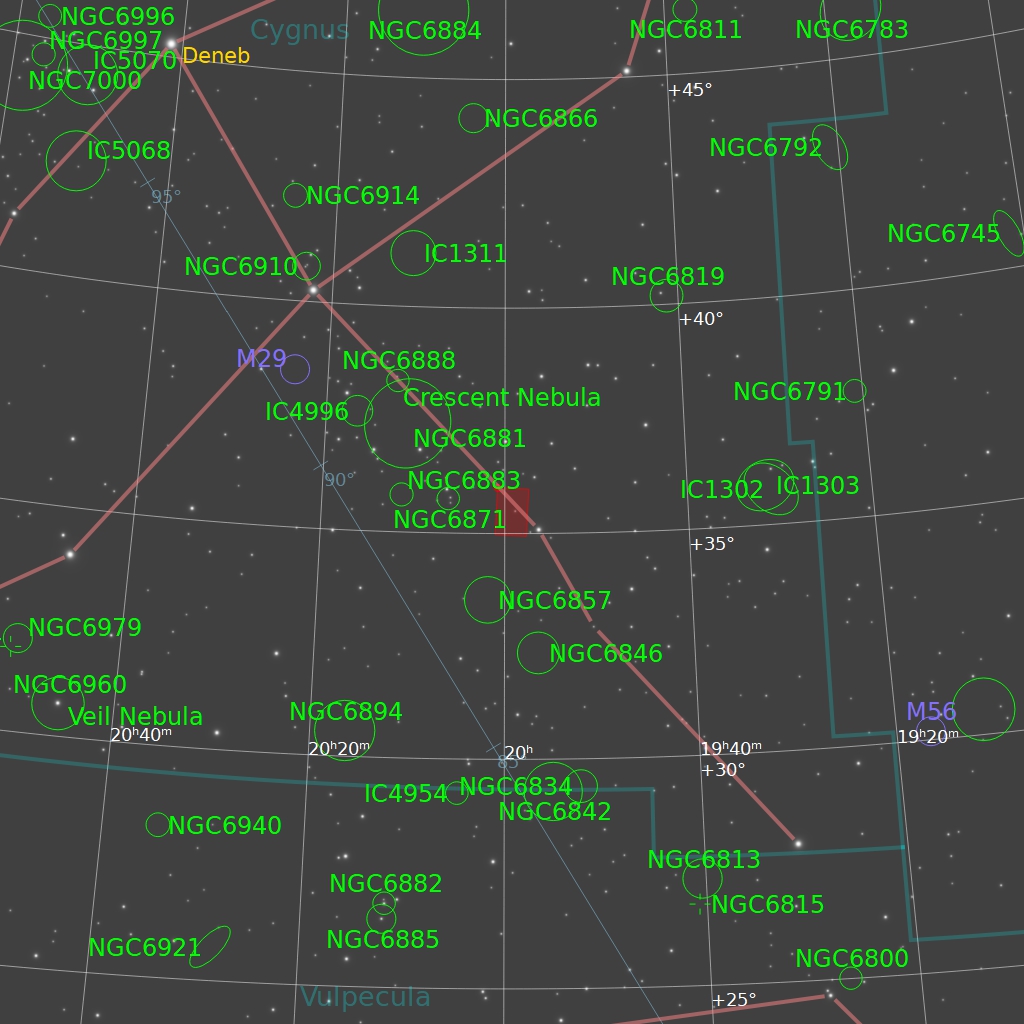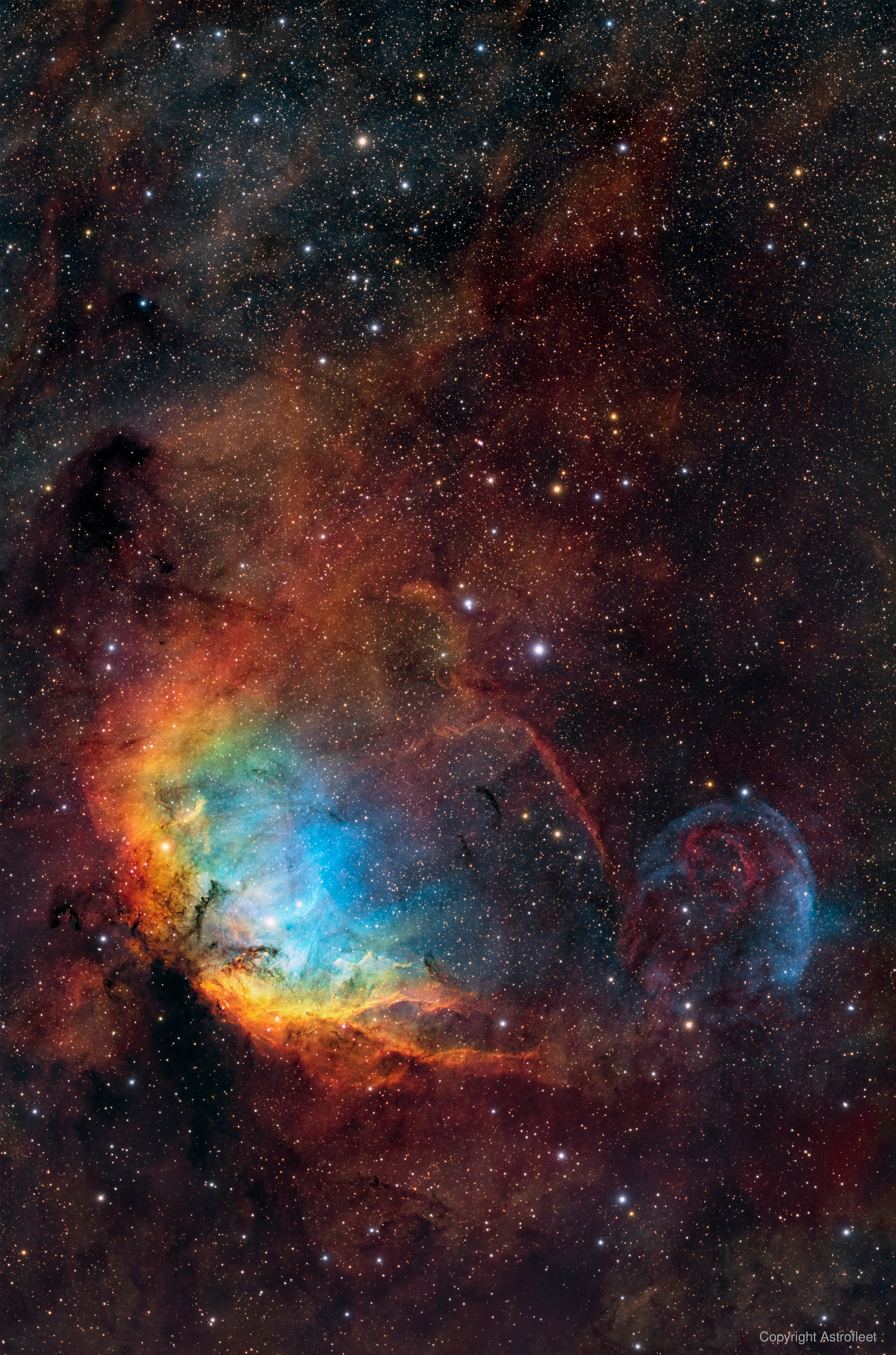Tulip Nebula
& Cygnus X-1 Bowshock
Sh2-101 & Cygnus X-1
Our version of Sh2-101 and the BowShock with the whole AstroFleet team. The data were acquired with our setup (TS-Optics CF-APO 155mm & ASI2600MM Pro) hosted at PixelSkies, Spain. Astrobin version here.
Sharpless 101 (also called The Tulip Nebula) is an HII region emission nebula situated in the constellation Cygnus. Known as the Tulip Nebula due to its shape when captured, it was cataloged by astronomer Stewart Sharpless in 1959. The nebula is approximately 6,000 light-years (about 5.7×10¹⁶ km or 3.5×10¹⁶ mi) away from Earth.
In the same region of the sky, Sh 2-101 is located near the microquasar Cygnus X-1, one of the first known black hole candidates, discovered in 1965. The black hole in the Cygnus X-1 system is estimated to have a mass of about 21.2 solar masses. This system is a high-mass X-ray binary, consisting of the black hole and the supergiant star HDE 226868, which orbits the black hole at a distance of approximately 0.2 astronomical units (AU). The intense X-rays emitted by Cygnus X-1 are generated by material heated to millions of degrees in an accretion disk, fed by the stellar wind from HDE 226868. As a key example of microquasars, Cygnus X-1 exhibits features similar to active galactic nuclei, making it instrumental in advancing our understanding of black holes and accretion processes. The system gained additional fame due to a well-known wager between Stephen Hawking and Kip Thorne concerning the existence of black holes, a bet Hawking eventually conceded based on overwhelming observational evidence. The black hole's properties, including its relativistic jets and X-ray variability, remain crucial for ongoing research in astrophysics.
This picture respects the Hubble Palette version (SHO): H-Alpha mapped to green, SII mapped to red and OIII mapped to the blue channel. While the colors in this image are not the true colors, the narrowband filters were used to create the nebula color.
Les données ont été acquises avec notre setup hébergé chez PixelSkies en Espagne.
Sharpless 101, également connue sous le nom de Nébuleuse de la Tulipe en raison de sa forme, est une nébuleuse en émission située dans la région HII de la constellation du Cygne. Elle a été cataloguée en 1959 par l'astronome Stewart Sharpless. La nébuleuse se trouve à environ 6 000 années-lumière de la Terre, soit environ 5,7×10¹⁶ km ou 3,5×10¹⁶ miles.
Dans la même région du ciel, Sh2-101 se trouve à proximité du microquasar Cygnus X-1, l'un des premiers candidats identifiés comme un trou noir, découvert en 1965. Le trou noir de Cygnus X-1 possède une masse estimée à environ 21,2 fois celle du Soleil. Ce système, un binaire X de haute masse, est composé du trou noir et de l'étoile supergéante HDE 226868, qui orbite à environ 0,2 unités astronomiques (UA) du trou noir. Les puissants rayons X émis par Cygnus X-1 sont produits par la matière chauffée à des millions de degrés dans un disque d'accrétion, alimenté par le vent stellaire de HDE 226868. Cygnus X-1, en tant qu'exemple majeur de microquasar, partage des caractéristiques avec les noyaux actifs de galaxies, jouant ainsi un rôle crucial dans l'approfondissement de notre compréhension des trous noirs et des processus d'accrétion. Le système a également acquis une notoriété supplémentaire grâce à un pari célèbre entre Stephen Hawking et Kip Thorne sur l'existence des trous noirs, un pari que Hawking a finalement perdu face à des preuves observationnelles convaincantes. Les caractéristiques du trou noir, notamment ses jets relativistes et sa variabilité en rayons X, continuent de représenter un enjeu majeur pour la recherche en astrophysique.
Cette image respecte la palette de couleur Hubble (SHO) : Le H-Alpha correspond au canal vert, le SII correspond au canal rouge et le OIII correspond au canal bleu. Des filtres à bandes étroites (narrowband) ayant été utilisés pour créer cette image, les couleurs de la nébuleuse ne représentent pas les vraies couleurs.
TECHNICAL DATA
ACQUISITION DETAILS
OPTICS TS-Optics CF-APO 155mm @ F/8
CAMERA ZWO ASI2600MM Pro
MOUNT iOptron CEM70
FILTERS Ha, OIII, SII, R, G, B
LOCATION PixelSkies, Castilléjar, Granada, Andalucia, Spain
DATE July 2024
EXPOSURES 85.7 hours (Ha 405 x 300 sec, OIII 345 x 300 sec, SII 278 x 300 sec, R 59 x 180 sec, G 49 x 180 sec, B 51 x 180 sec)
PROCESSING SOFTWARE Pixinsight, CCDstack, Photoshop
COPYRIGHTS Team AstroFleet

TARGET DETAILS
RA 19h 59m 12.7s
DEC +35° 28' 46.3"
SIZE 41.6 x 63 arcmin
ORIENTATION Up is 2.6 degrees E of N
CONSTELLATION Cygnus
